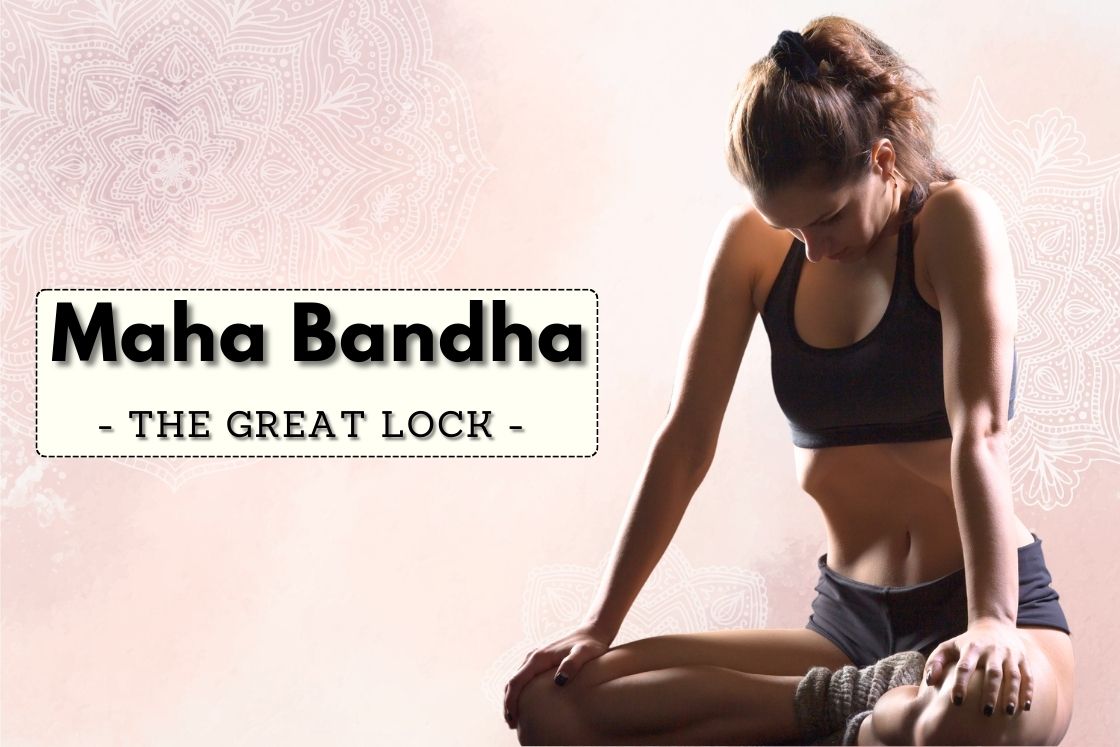Maha Bandha: Benefits, How to Perform and Precautions
When it comes to ancient yogic practices, Maha Bandha stands as a profound and comprehensive technique to controlling the Prana (vital life force). In Sanskrit, ‘Maha’ signifies ‘great’ or ‘supreme’, while ‘Bandha’ translates to a ‘lock’, aptly defining Maha...


When it comes to ancient yogic practices, Maha Bandha stands as a profound and comprehensive technique to controlling the Prana (vital life force). In Sanskrit, ‘Maha’ signifies ‘great’ or ‘supreme’, while ‘Bandha’ translates to a ‘lock’, aptly defining Maha Bandha as the ‘Great Lock’.
Maha bandha is called the ‘Great Lock’ in Sanskrit because it combines three key Bandhas (Yogic locks) – Mula Bandha, Uddiyana Bandha, and Jalandhara Bandha – into a single, powerful practice.
Maha bandha practice is deeply rooted in traditional texts like Hatha Yoga Pradeepika, Gheranda Samhita, and Siva Samhita. It is renowned for activating prana shakti and facilitating the awakening of Kundalini Shakti at the spine’s base.
This guide is crafted to enrich your understanding of Maha Bandha, detailing its step-by-step procedure, benefits, and necessary precautions.
The Three Bandhas
Bandhas in yoga are specific body locks where you contract and control certain muscle groups. A bandha is practice of constraining muscles of a certain area of the body to lock the energy within this area.
These practices help to regulate and direct the flow of energy, or prana, within the body. Think of bandhas as valves that manage this energy flow, enhancing both physical postures and mental concentration. There are three main bandhas:
Mula Bandha (root lock) Uddiyana Bandha (abdominal lock) Jalandhara Bandha (throat lock)The fourth bandha is Maha Bandha which is formed by combining the three main bandhas.
Maha Bandha
 Udiiyana Bandha (abdominal lock) with Jalandhar bandha. Image Source: Shutterstock
Udiiyana Bandha (abdominal lock) with Jalandhar bandha. Image Source: ShutterstockMaha Bandha, often called the “Great Lock,” is a advanced yoga practice that combines three specific bandhas: Mula Bandha (root lock), Uddiyana Bandha (abdominal lock), and Jalandhara Bandha (throat lock) – into a single, powerful practice.
By engaging these three locks simultaneously, Maha Bandha creates a comprehensive energy control system within the body in a way that no other single bandha can achieve. This comprehensive control and channelization of energy is what makes Maha Bandha ‘great’ in its impact on both physical and spiritual levels. It’s considered an advanced technique and is highly revered in yoga for its ability to harmonize and elevate the practitioner’s overall energy system.
Maha Bandha is also referred to as the tri-bandha or triple lock as it integrates the power of all three major locks to channel pranic energy in a unique and potent manner.
Maha Bandha Mudra
When Maha Bandha classify as a Mudra, it highlights its role in directing energy and in context of Bandha alone, it emphasizes the creation of an energy lock.
Maha Mudra and Maha Bandha are two distinct yet interconnected practices in yoga, each offering unique benefits. Maha Mudra comprises specific yoga posture which focuses on physical movements combined with breath control to awaken spiritual energy and harmonize the body’s systems. In contrast, Maha Bandha involves the simultaneous activation of three major yogic locks – Mula Bandha, Uddiyana Bandha, and Jalandhara Bandha.
How Bandhas Control Energy (Prana) in the Body?
Bandhas act as energy valves. By strategically engaging specific body parts, they lock or redirect the flow of prana, thus intensifying its impact. Each bandha targets a different energy center, harmonizing and balancing the flow of life force throughout the body.
Let’s use the analogy of a dam in a river to understand this concept better:
Mula Bandha (Root Lock): This is akin to closing a gate at the river’s source, the pelvic floor. By contracting these muscles, you prevent energy from flowing downwards, instead directing it upwards along the spine. Uddiyana Bandha (Abdominal Lock): Imagine this as creating a powerful upward current in the river’s middle section (the abdomen). By drawing the abdomen in and up, you create a vacuum that pulls prana upwards, stimulating the internal organs and aiding digestion. Jalandhara Bandha (Throat Lock): This resembles a lock at the river’s upper course, near the throat. Lowering the chin to the chest compresses the energy flow in the neck, regulating the thyroid and creating a balance in the upper body’s energy.When these three are engaged simultaneously in Maha Bandha, it’s like operating a sophisticated system of locks in a river, creating a powerful surge that lifts the river’s entire energy upwards. This unified action intensifies the flow of prana throughout the body, unifying and elevating the energy from the base of the spine to the crown, akin to a river flowing powerfully and smoothly towards its destination.
How to Do Maha Bandha?

To practice Maha Bandha, exhale forcefully completely emptying your lungs, first engage Jalandhara Bandha by bringing your chin towards your chest. Following this, simultaneously activate Mula Bandha by contracting the muscles at the base of your pelvic floor. Then, bend slightly forward and ‘suck up’ your abdomen to engage Uddiyana Bandha, completing the Maha Bandha.
To release Maha Bandha, reverse the order in which you engaged the three bandhas: start by releasing Mula Bandha, followed by Uddiyana Bandha, and finally relax Jalandhara Bandha. This sequence harmonizes the flow of energy in the body, integrating the benefits of all three individual bandhas.
Here are the step-by-step instructions to perform Maha Bandha:
Begin your practice by sitting on your yoga mat in either Lotus Pose (Padmasana) or Accomplished Pose (Siddhasana). Ensure that you are comfortable and stable in your chosen pose. Gently close your eyes, allowing yourself to settle into the moment. Place your palms on your knees, and slightly raise your shoulders while tilting your body forward to prepare for the bandhas. Take a few deep breaths to center yourself. With each inhalation and exhalation, feel your body relaxing and your mind becoming more focused. Start by exhaling completely. As you reach the end of your exhalation, engage Jalandhara Bandha by dropping your chin to your chest, creating the throat lock. Next, engage Uddiyana Bandha. Draw your abdomen in and up, creating an upward energy flow in the core of your body. Finally, activate Mula Bandha. Contract the muscles at the base of your pelvic floor, completing the formation of Maha Bandha. Concentrate on any one chakra or rotate your focus between three chakras – Throat Chakra, Solar Plexus Chakra, and Root chakra. Hold these three bandhas simultaneously for a few seconds, being mindful not to strain yourself. Focus on the energy being directed upwards through your spine. To release Maha Bandha, reverse the order of the locks. Begin by releasing Mula Bandha (loosen your pelvic floor muscles), followed by Uddiyana Bandha (release abdominal muscles), and finally, Jalandhara Bandha (bring your chin up). Inhale gently as you return to a neutral position. Rest for a moment, taking normal breaths. Observe the sensations in your body and the flow of energy. Repeat the process as per your comfort level, ensuring not to overexert yourself.Tips for Different Levels of Yoga Practitioners
Beginners: Focus on understanding and feeling each bandha individually before attempting Maha Bandha. Start with short durations and do not strain. Intermediate Practitioners: Work on refining the engagement of each bandha and smoothly transitioning into Maha Bandha. Begin to extend the duration of the locks as comfort allows. Advanced Practitioners: Explore deeper levels of internal energy manipulation and focus on the subtle aspects of the practice. Integrate Maha Bandha into other yoga asanas and meditation practices for enhanced benefits.Remember, the practice of Maha Bandha is advanced and should be approached with respect to your body’s capabilities and limitations. Always listen to your body and practice under the guidance of an experienced yoga instructor, especially if you are new to bandhas.
Maha Bandha Benefits
Maha Bandha is a comprehensive yogic practice that offers a wide range of benefits, encompassing physical, spiritual, and emotional aspects. The practice enhances vital functions of the body, especially regulating the thyroid gland, digestive system, and improving the efficiency of the respiratory system. This practice not only boosts metabolism and aids in better digestion but also enhances lung capacity and breathing quality. Spiritually, it aids in energy regulation and awakening, leading to heightened consciousness. Emotionally, it promotes mental clarity and emotional stability, creating a sense of inner peace and balance.
Here are some major benefits of Maha bandha kriya:
Improves Digestion: Maha Bandha practice stimulates the abdominal organs, enhancing the digestive process and aiding in more efficient nutrient absorption and waste elimination. Regulates Endocrine System: The practice aids in balancing hormonal secretions, which is vital for maintaining physical and mental health. Increases Mental Clarity: Regular practice clears mental fog, thereby improving focus and concentration, essential for both personal and professional life. Boosts Physical Vitality: It strengthens core muscles, thereby increasing overall energy and stamina. Stimulates Kundalini Awakening: Maha Bandha facilitates the upward movement of Kundalini energy along the spine, leading to spiritual growth and enlightenment. Promotes Emotional Balance: The practice helps in managing stress and emotional fluctuations, leading to greater emotional stability and resilience. Improves Respiratory Efficiency: It enhances lung capacity and the quality of breathing, beneficial for respiratory health. Supports Cardiovascular Health: The practice can positively influence heart rate and blood pressure, contributing to better cardiovascular health.Importance of Maha Bandha Practice
Maha Bandha plays a crucial role in the yogic practice, primarily by harmonizing and elevating the body’s energy system.
The practice of Maha Bandha effectively halts the upward dispersion of Prana Vayu and the downward release of Apana Vayu. By preventing these vital energies from dissipating, Maha Bandha fosters Prana vayu and Apana Vayu union. This convergence harmonizes Samana Vayu, located at the navel center, which is crucial for effective digestion and distribution of energy throughout the body.
With Samana Vayu in equilibrium, the digestive processes are enhanced, leading to better assimilation of nutrients and more efficient removal of toxins. This equilibrium lays the foundation for a well-balanced energy system, contributing to overall vitality and well-being.
Secondly, Maha Bandha impacts the Ida and Pingala nadis through the regulation of energy and breath. The process of holding the breath and engaging bandhas one by one in Maha bandha practice alters the energy flow and pressure within the body. This alteration helps to equalize the functioning of the left and right sides of the body, associated with Ida and Pingala respectively. It leads to the activation of the central Sushumna Nadi.
Since Maha Bandha helps directing prana into Sushumna Nadi, the central energy channel, it’s very important practice for awakening the Kundalini energy. This energy ascension through the chakras, particularly activating the Ajna Chakra (third-eye), leads to higher states of consciousness and spiritual awakening.
Precautions and Contraindications of Maha Bandha
One should keep these safety points in mind when approaching Maha bandha practice:
Gradual Progression: Maha Bandha should be approached progressively. Start by mastering individual bandhas – Jalandhara, Mula, and Uddiyana – before attempting Maha Bandha. Mindful Breathing: Pay close attention to your breath while practising Maha bandha. Avoid excessively prolonged breath retention, especially if you are new to this practice. Listen to Your Body: Be aware of bodily sensations. If any discomfort arises, gently release the bandhas in order and relax. Seek Professional Guidance: It is recommended to practice under the supervision of a trained yoga instructor, particularly for those new to bandhas.Note: Practicing Maha Bandha is strongly recommended before attempting Nauli Kriya in the Shatkarmas sequence. This practice significantly enhances the conditioning of the Rectus Abdominis muscle, which is crucial for effectively performing Nauli.
Contraindications
Avoid doing Maha bandha in case of following conditions:
Blood Pressure Concerns: Individuals with high or low blood pressure should refrain from practicing Maha Bandha due to its potential impact on blood circulation. Heart Conditions: Those with heart issues should avoid this practice, as the intensity of the bandhas might strain the heart. Pregnancy and Menstruation: The intense abdominal engagement in Maha Bandha is not advisable during pregnancy and menstruation. Post-Surgery Recovery: If you’ve recently had surgery, especially in the abdominal, thoracic, or spinal regions, avoid this practice to prevent strain on these areas. Existing Hernia or Ulcers: The abdominal contraction in Maha Bandha can aggravate conditions like hernia or ulcers.Conclusion
Maha Bandha stands as a significant practice in yoga, combining the essence of Mula Bandha, Uddiyana Bandha, and Jalandhara Bandha into one potent technique.
This practice not only enhances physical well-being by improving digestion and hormonal balance but also elevates mental clarity and spiritual consciousness. The integration of three individual bandhas in Maha Bandha serves as a powerful tool for controlling and directing the body’s pranic energy, leading practitioners towards higher states of awareness and self-realization.
While it offers profound benefits, Maha Bandha requires a disciplined approach, emphasizing the importance of gradual progression and mindful practice within the journey of yoga.
FAQs Related to Maha Bandha
Q1. What is Maha Bandha?
Maha Bandha, or the Great Lock, combines three key bandhas – Mula Bandha, Uddiyana Bandha, and Jalandhara Bandha – into a singular, powerful yogic practice.
Q2. Who should practice Maha Bandha?
It’s suitable for intermediate to advanced yoga practitioners who have mastered the individual bandhas.
Q3. Can beginners try Maha Bandha?
Beginners should first become proficient in each of the individual bandhas before attempting Maha Bandha.
Q4. Are there any risks associated with Maha Bandha?
Yes, individuals with heart conditions, high or low blood pressure, hernia, ulcers, or those who are pregnant should avoid this practice. It’s also important to not overstrain while holding the bandhas.
Q5. What is the purpose of Maha Bandha?
The purpose of Maha Bandha is to harness and intensify the body’s pranic energy by integrating three specific yogic locks – Mula Bandha, Uddiyana Bandha, and Jalandhara Bandha. This powerful combination aids in the upward flow of energy, balancing physical, mental, and spiritual aspects.

 Fransebas
Fransebas 































